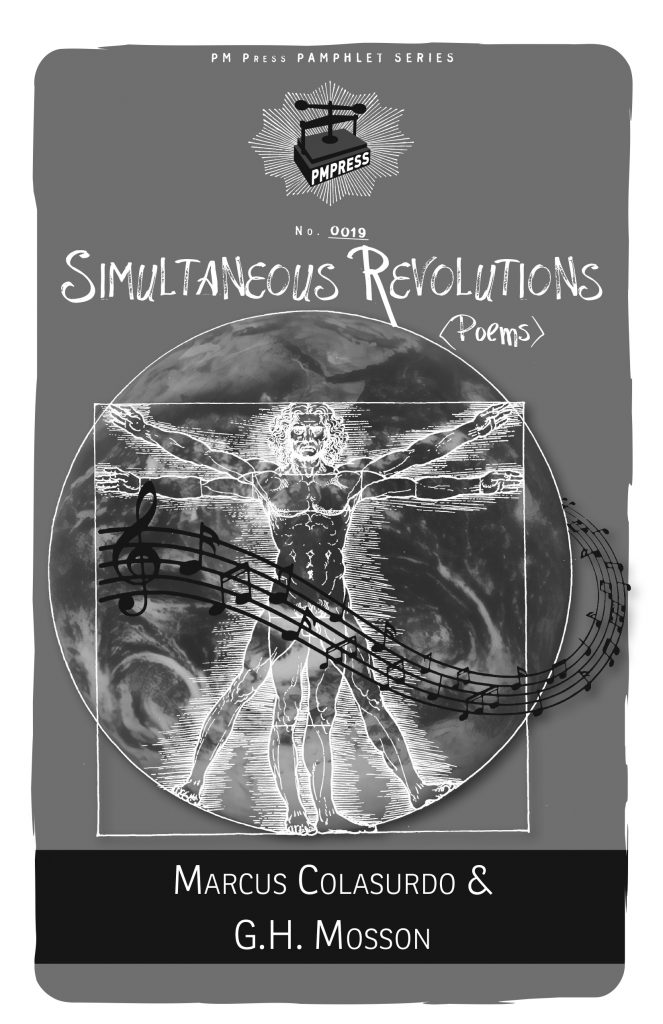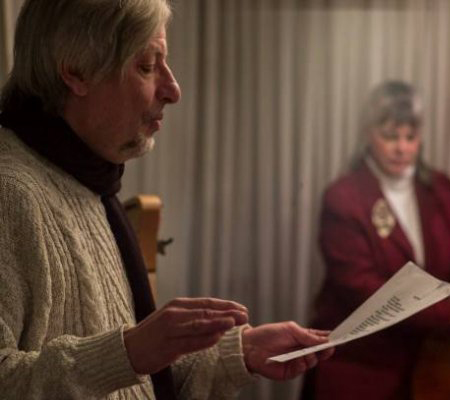By Dan Cuddy
The Loch Raven Review
“Simultaneous Revolutions” is a lyrical celebration and a rhetorical exploration of the many political, cultural, technological, and personal revolutions of the last 60 years of American history. It is the progressive story. It is true that the present is a continuation of the Civil War, of democracy and autocracy, of individual freedoms vs. privilege, of the human vs. the almost overwhelming reduction of every human value to the worship of wealth and power. These battles are playing out in the world very much in but beyond this book. However, the book validates and emphasizes what it is like to live in contemporary America.
The subjects of the poems are the symbols which illuminate the truths and battles of society as aggregate and of the individual psyche and heart. The symbol could be a mailbox or a highway, Allen Ginsberg or Bob Dylan, the Sex Pistols or Dolores O’Riordan and the Cranberries.
The book is a collaboration of two individual poets: Marcus Colasurdo and Gregg Mosson. Books of poetry are usually individual endeavors, yet this partnership seems to work well. I have no idea what the writers bring individually to the task. Is Mosson the romantic lyricist and Colasurdo more the avant-garde architect of the poems? Did each predominately contribute whole poems to the mix or collaborate together on the majority of the works? Are they kind of a Lennon-McCartney team, inspiring each other with lines, phrases, symbols? I don’t know. Maybe, they might reveal the behind-the-scenes workings one day, or, maybe, they will keep the recipes and creation of the product secret, leaving the creative moments, their textual expression, and the origin speculation for a surmising critic. What matters, of course, is the printed word, the fruit of the labor.
The book is divided into three sections, titled “If”, “Rumor”, “Flags.”
An important poem is this short bit of lyrical and rhetorical call to arms so to speak: Here is the short, but long on meaning “Enter Through IF”
Let’s inhabit this music alone
and not alone, dancing in society’s clothes
rearrange from a thrift store, and blur
through the lustful longing of Grimes
on the stage behind her console of giddy electronics
together with us in an abandoned warehouse.
Our harmonies and disharmonies
cross over walls, customs, labels
in wavelengths. Sense the crack.
squeeze through a cloud,
embody shapes, touch my body
gentle as drizzle, never look back.
“Rumor” discusses the past and the state the present is in. The section “Flags” is expressed briefly in the poem “Flag (Work Ahead)”:
What would it broadcast, the flag
of the future conceived by your heart?
What cloth would you choose
to make public and plain
the look of your dreams?
Through what language seen
out of blood and brains
would you stitch
the totem of your settlement?
Sometimes the poets in an idiosyncratic effective script bring their own revolution to their own work, as in the opening stanza of “Thinking Apart.” Look at the typography and images and message below:
YOU follow me into the CONVENIENCE store,
warehouse rave, bathroom STALL, knickknack shop,
down the garbage CHUTE of longing
far from those I’ve ABANDONED
because they spoke GOBBLEDYGOOK to me
(where even I can’t SEE) until I suffer
delightfully into some NEW love’s arms
to find myself DANCING, but
the record has REPEATED enough.
A back cover blurb written by the accomplished poet Michael Salcman points out the wonderful variety of invention and form these poets bring to this endeavor. The mechanics of a poem make the revolution of its recording spin.
Also, there is an important social consciousness in this dynamite little book of poetry. “Liberte’ Haikus” begins with these four insights that speak to the present:
Standing-Rock, tear-gassed,
now come cuffs from oil man’s cops,
we hold sacred ground.
We kneel, Saint Louis,
and pray for the gunned-down child.
When we rise, justice.
To a homeless soul
this Vermont winter, the boon
of one hot shower.
How many more wounds
will the earth endure be
fore
she withdraws balance?
A few years ago, Mosson and Colasurdo wrote “Heart X-Rays: A Modern Epic Poem” published by the same publishers. The current book has both a higher ceiling and a higher floor.
Look at the comparatively short section of the magnificent poem “Soulphone Ringing”
Headed down the wounded highway
like a nurse on the same road.
don’t know what the banners say today,
but sense the ill from the good.
In the third section of the poem is this telling and wonderful statement, written in the context of the poem and the book as a whole—-I’ll cheat and leave the artful flow and weave of the poem to the future reader’s discovery, but the statement can be quoted, even out of context, and shine:
“What is revolutionary….what action,
Work is FUNDAMENTALLY different from the old
Thinking about soil…planting…upheaval…
how the turning of the soil, come spring,
reveals uses of the dead
and yes, what dies
releases nitrogen which
enriches the earth
as revolution includes evolution
in substance through decomposition,
a creative act yielding
new growth. It keeps us all alive.
What if a mind thought about $$$$$$ that way?
Dreaming a lot this week,
Much luv bro,
The Other Bill.”
Note—-the vernacular, the slang of everyday American life, like the allusions and recall of contemporary music, is very much a component of the poets’ dialogue, style. There are sections of formality, but that is a backdrop to the conversational, the contemporary idiomatic, and vice versa.
My favorite poem in the book is “Tilling.” Check out the lyricism of the first stanza.
The earth feels endless, a teacher of depths.
In the sun working the dirt,
I’ve come to know
the turning of soil,
how it yields and surprises.
Under my blades,
clods and clumps fly up
brown and web-woven;
stones exchange silent respect;
and a tiny ivory onion
falls asleep in the palm
of the spade.
Worms ooze, uprooted.
An eggshell winks
and small birds slowly draw closer
to my kneeling
as above the sepia clouds
whirl and an odd sort of freshness
blends with my sweat.
This book is more a living entity than most books of poetry. The words not only perform but they also engage the reader’s own reality and teach the reader to see, feel. The stanzas and excerpts of the poetry presented in this review are only teasers to the wealth found within its covers.
© Marcus Colarsudo & G.H Mosson and Dan Cuddy
Marcus Colasurdo is the author of 11 books, including the underground classic novel, Angel City Taxi. He is the founder of Gimme Shelter productions, a nonprofit of artists who raise money for homeless shelters and feeding programs . He founded Soul Kitchens in Baltimore, MD and Hazelton, PA.
G.H. Mossonis the author of 4 books of poetry. His work has been published in The Tampa Review, Cincinnati Review, Measure and the Evening Street Review .Over the years he has organized for fair trade, not free trade, and for environmental conservation.
Dan Cuddy is currently an editor of the Loch Raven Review. Most recently he has had poems published in the End of 83, Broadkill Review, Welter, the Twisted Vine Literary Journal, the Pangolin Review, Madness Muse Press, Horror Sleaze Trash, the Rats’s Ass Review, Roanoke Review.

Back to G.H. Mosson’s Author Page | Back to Marcus Colasurdo’s Author Page






